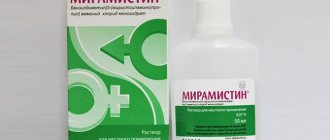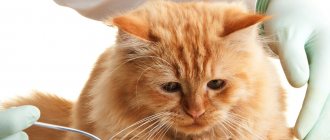Correctly cleaning a cat’s ears is a science, as practice shows, simple, but mandatory. Fluffy “locators” often receive little attention from their owners - and in vain. Behind an inattentive attitude lie terrible illnesses, frayed nerves, and anxiety for a pet. You need to make it a rule to carefully monitor your pet’s health and not forget about ear hygiene.
Need for cleaning
Should cats' ears be cleaned and why? The hearing aid has a very complex structure, hence there are so many practical questions.
Like other mammals, cats have glands that produce a special secretion - sulfur. This is a natural process necessary to protect the middle ear from dust, foreign particles and harmful microorganisms. Sulfur is released naturally during chewing of food, and the animal itself removes its excess while washing.
The process does not always go smoothly, and some individuals require the help of the owner.
Hygiene
Often the secretion that is not released accumulates, forming sulfur plugs, leading to hearing impairment. By putting pressure on the eardrum, the plug provokes unpleasant sensations in the form of pain, nausea, and dizziness.
It should be remembered that the auditory canal, in addition to the perception of sound, performs another function - it is responsible for the position of the body in space and the ability to maintain balance. In other words, it is closely connected with the vestibular apparatus, so if cleaning is not carried out on time, it can lead to deterioration of coordination.
Hygienic cleaning is performed if necessary - if the owner of the animal notices accumulations of wax in the ear. The ear needs to be examined weekly: if there is a dark or yellowish coating, it is carefully removed without going deep.
Prevention and treatment of diseases
The first examinations must begin at an early age, trying to accustom the kitten to the procedure, since it must be performed constantly. If you do not regularly inspect and clean, parasites may appear in the ear canal - wax is a good breeding ground for ear mites.
The increased attention of the four-legged animal to its “locators” can be considered an alarm bell. The animal begins to constantly itch, trying to get something out of the ear canal, or shake its head. If you observe such symptoms, take your mustachioed friend to the veterinarian immediately.
When treating ear diseases, you need to clean them 1-2 times a day with special products. The veterinarian will prescribe a regimen of procedures in accordance with the identified pathology.
Frequency of procedure
The amount of sulfur produced is influenced by many factors: breed, diet, activity, environment. Since the cat's “locator” is very sensitive to touch, too frequent intervention can cause unpleasant associations. Therefore, owners are worried about how often to clean their cat’s ears so as not to cause harm and not miss the onset of the disease?
There is no consensus among veterinarians. A lot depends on the breed of the pet - for example, hairless cats do not have hairs in their shells, so they produce an excess amount of sulfur for better protection.
Fold-eared breeds also need close attention - their ear canal is covered, and therefore ventilation is difficult. Also, increased secretion of sulfur is observed in older animals, individuals with chronic diseases, and in cats who have suffered from ear mites.
Accordingly, for such pets, inspection is carried out every two to three days, and cleaning is done every three to four days. For other breeds, an inspection once a week is sufficient. Do not confuse examination and cleaning - it is quite possible that your pet will only need intervention once every 3-4 months.
How to clean wax from ears?
It is enough to carry out the ear cleaning procedure once a week if the animal is healthy. In case of illness, the frequency of cleansing will depend on the type of illness, as a rule, 2-3 times a week. The cat needs to clean its ears so as not to injure the animal. Special earwax drops for cats and cleansing gels will make the manipulation more comfortable. They can be purchased in specialized stores and pharmacies.
It is not recommended to use alcohol-containing and soap solutions yourself for instillation into the ears. This can provoke even greater release of sulfur.
To clean the auricle you will need cotton pads onto which cleansers are applied. A new disc is used for each ear. Cotton swabs are used with great care so as not to damage the eardrum. In a healthy cat, it will be enough to clean the ear shallowly by bending back the auricle. If difficulties arise, it is better to contact a veterinarian.
We recommend reading: Skin Diseases in Cats Photos
Regular grooming of your pet will help keep it healthy.
The health of a pet depends to a large extent on how carefully the owner takes care of it. Particular attention should be paid to the cleanliness of the cat. One of the main stages of hygiene is to ensure that large amounts of wax do not accumulate in the ears of cats.
Cat ear cleaners
There are a large number of remedies: some are intended for prevention, others for the treatment of diseases. The former can be purchased at a veterinary pharmacy or pet store, the latter must be purchased in accordance with the recommendations of a veterinarian.
For diseases
In case of serious illnesses, it is better to immediately contact a veterinarian. Before your initial visit to the clinic, it is better not to remove the contents of the auricle, as this may complicate the diagnosis.
Any medicinal prescriptions must be made by a doctor. Incorrect, self-selected treatment can cause bacteria to become resistant to antibiotics, as well as chronic inflammatory processes.
For hygienic purposes
For regular cleaning, available products are suitable: chlorhexidine or Vaseline. For more thorough cleaning, you can use medications from veterinary pharmacies: drops and lotions. Products are often released as sprays, which simplifies the cleaning process.
Prevention
It is possible to prevent the appearance of pathological discharge from the ear. To do this you need:
- Minimize contact with ARVI patients.
- See a doctor promptly if you have ear problems.
- Avoid hypothermia, water and other liquids getting into the ear canal.
- Have wax plugs removed by a doctor.
- Wash your ears regularly and do not use cotton swabs to clean them.
Preventing a disease is always easier than treating it. Discharge from the ears is only a symptom of pathology. It is not worth treating it in isolation. It is necessary to consult a doctor and engage in comprehensive healing of the body.
Author: Denis Volynsky, doctor, especially for Moylor.ru
How does the procedure work?
Since cleaning a cat’s ears at home is not at all difficult, owners can do it on their own. If the cat has been trained since childhood, hygiene measures can be easily carried out alone. For a stubborn animal, two people will most likely be needed.
Preparation
First you need to prepare all the tools and tools. Bottles and drops must be opened to act as quickly as possible.
Choose a place for the event - a quiet and bright room will do. If the procedure takes place in the dark, prepare a good lamp. Place it comfortably and steadily so that the light falls on the animal.
Next, gently secure your pet. This can be done by sitting him on your lap and squeezing him slightly towards you. If your pet breaks out and it becomes difficult to hold him, then available means will come to the rescue. You can swaddle your four-legged dog with a towel, protecting yourself from claws and teeth. Holding the animal's head with one hand, you can carry out the procedure with the other hand.
Another option is a retainer bag. It will free both hands of the owner and allow you to quickly carry out any hygiene procedure.
The third option is to enlist the help of household members. One person will hold and calm the cat while the other quickly examines and, if necessary, cleans the ears.
Algorithm of actions
After the mustachioed friend is immobilized and does not pose a threat to the owner, you can proceed to the main steps:
1.
Inspect the ear for discharge, scratches, or injuries. To do this, carefully turn it out. This is not dangerous and will not harm your mustachioed friend.
What you need to pay attention to:
- an unpleasant odor indicates suppuration or malignant formations;
- blood discharge: blood occurs with dermatitis and otodectosis, when the animal begins to scratch the affected areas vigorously, injuring the skin;
- tumor - looks like a hard nodule.
2.
Soak a napkin in the lotion and then squeeze it out so that excess moisture does not remain inside. Another option is to buy impregnated veterinary wipes.
3.
Gently rub a napkin or cotton pad over the contaminated areas. There is no need to penetrate deep into the ear canal, as this may subsequently cause the formation of wax plugs. The entire procedure must be performed within sight. Small stains can be removed with a cotton swab - but only from the outside.
4.
After the procedure, praise the animal and give it a treat. The pet should be left with a positive impression - he was not hurt, and then he was given a treat. Next time he will take the cleaning more calmly.
There is another option for cleaning your cat's ears at home. This method is appropriate when a lot of dust and dark secretions have accumulated:
- Take the drops and warm them to a comfortable (slightly above room) temperature. The solution should not be cold or hot.
- Drop the liquid into the ear canal and gently massage the base of the ear so that the medicine penetrates inside.
- Shake your pet's head to shake out excess solution. The bulk of the contamination will come out. If you need to remove residue, use a cotton swab. It is important not to make sharp circular movements so as not to injure the auditory organ.
Always be as gentle as possible with your pet, as such manipulations are stressful for them. Over time, when the cat gets used to it, everything will be perceived much easier for him.
How to clean a kitten's ears
How to clean a kitten's ears? Just like an adult cat, cleaning a baby’s ears is not difficult. But you need to act more delicately. Firstly, kittens have smaller ear canals, which means the cotton swabs will be too big. Secondly, you need to be careful when restraining a small pet.
Drops that are gently dripped into the ear canal and onto the inner surface are well suited for the procedure. After instillation, it is necessary to massage the shell for several minutes - for better penetration of the medicine. As with adult cats, it is best to massage at the base.
After this, release the kitten and let him shake his head so that the medicine along with the contamination comes out. Then wipe the kitten's head with a towel or cotton pad.
There is no need to thoroughly clean dirt from kittens - you risk causing damage. If the dirt has accumulated deeply, it is better to seek help from a veterinarian.
What not to do
There are a number of actions that absolutely cannot be performed:
- Under no circumstances should you wash your hearing organ with plain water. Always keep an eye on this when swimming - water should not get inside. It can provoke inflammation and suppuration, that is, otitis media.
- Chlorhexidine is not suitable for instillation. It should only be used for external cleaning.
- Do not use hydrogen peroxide, soap or alcohol-containing solutions. “Traditional medicine” can greatly harm your mustachioed friend: they dry out the skin, kill natural microflora and cause an allergic reaction.
- When restraining the animal, always make sure that it has something to breathe. The animal should be in a position that is comfortable for it.
Never forget the importance of the above-mentioned nuances. With some skill, you will learn how to check and clean your pet's ears quickly and without stress for both of you.
Ear wax in cats
Sulfur, which is produced in the ears of animals, suppresses the development of pathogenic microflora and is a natural lubricant for the ear canals. Too much sulfur can be a warning sign of disease development or a sign of improper care.
Why there is wax in the ears of cats and kittens, symptoms and causes, why, dangerous or not
A large amount of wax in the ears can be a sign of otitis media. In such cases, the animal’s ears hurt and cause anxiety. Cats can scratch them, shake their heads, meow pitifully, and rub their heads against various objects. The ears may leak pus and have an unpleasant odor.
Having discovered otitis in an animal, you need to visit a veterinarian and take smears to determine what caused the cat’s disease.
If your cat has a lot of wax in her ears, but she is not restless and there are no other signs of otitis, try changing the care of the animal. Buy an herbal lotion or ear rub from your veterinarian. Wipe your animal's ears daily. If the sulfur does not decrease, then consult a doctor.
Earwax in cats: how to treat and clean it at home
Earwax has an interesting property. The more often you clean it, the more it forms. In order not to cause hypersecretion of the sulfur glands, it is recommended to clean your pet’s ears once a week. If there is a lot of wax in the ears, this may also be a sign of otitis media.
When cleaning, use clean cotton wool or cotton swabs. You can’t get deep into your pet’s ears. At the veterinary pharmacy they buy a special lotion for ear care, for example, dewdrop or any other. Soak cotton swabs in lotion and wipe the animal’s ears. To dissolve the wax, place five drops of lotion in the ear, massage and then clean.
How to treat a British kitten, Maine Coon, has wax in his ears?
Ear wax does not always indicate the presence of a disease. It is produced by the sulfur glands to lubricate the ear and protect it from bacteria. Excess sulfur cannot cause ear inflammation or otitis media; this requires the presence of pathogens - mites or bacteria.
For prevention, you can buy broad-spectrum drops at the pharmacy and, after cleaning the animal’s ears with lotion, drop the drops. But it is better not to torture the animal and, without a confirmed diagnosis, use only lotion to clean the ears.
Earwax in cats and cats in one ear
When cleaning cats, you should use a different cotton swab for each ear. If the cause of excess wax formation is otitis, you need to drip in both ears to prevent the infection from spreading.
The presence of otitis may be indicated by an unpleasant odor, drainage from the ear, or restlessness of the animal. If these signs are absent, regular cleaning with ear lotion may help.
My cat has a plug in his ear, what should I do?
Removing the wax plug yourself will be problematic, and you may leave the cat deaf. If, when you drop cleaning lotion into the ear, the wax plug does not dissolve, you need to take the animal to the veterinarian. And then treat the animal’s ears weekly, preventing the formation of plugs.
Having discovered otitis in an animal, you need to visit a veterinarian and take smears to determine what caused the cat’s disease.
Features of caring for fold-eared cats
Fold cat ears are cleaned in the same way as any other pet. The nuance is that such breeds are not able to wash the “locators” themselves due to the unusual structure of the auricle. More frequent inspection and close attention will be required.
Proceed as usual. To begin, turn the ear outward (as it should be when properly cleaning a cat’s ears) and use a flashlight to illuminate the ear canal. Be careful - cats' cartilage is very delicate. If you notice plaque and dirt, remove it as you would a regular cat.
After the procedure, you will have to thoroughly dry the folded ear, because excess moisture can lead to diaper rash and the rapid formation of diseases.
Pathological causes depending on the nature of the discharge
The progression of otorrhea most often occurs due to the development of a pathological process in the outer or middle ear. Depending on the root cause of the pathology, the nature of the fluid that forms in the ears and flows out changes. When assessing the corresponding secretion, the doctor determines the main pathogenetic factor that caused the problem.
The following points are taken into account:
- Color.
- Aroma.
- Quantity.
- Presence of accompanying symptoms.
Establishing the cause of pathology in a person is carried out after basic diagnostic procedures and analysis of drops or streams that are released from the ear.
White cheesy masses are more common in infants and are a signal to parents that they need to visit a doctor. The causes of ear discharge in this case can be called:
- Fungal infection. The nature of the secret changes. White liquid is sometimes located throughout the ear canal and is accompanied by additional symptoms.
- Spinal cord damage. In this case, the children are very restless; at the same time, there is a high temperature and constant painful pulsation in the ear.
If a baby or adult patient begins to discharge white creamy masses, then you should consult a doctor as soon as possible.
Transparent
The appearance of a clear liquid may not be perceived by people as something bad. The symptom sometimes occurs without pain. However, the sign indicates the progression of the pathological process with a violation of the integrity of the eardrum.
We recommend reading: Treatments for Stroke in Dogs
Causes:
- Exudative otitis media. Aseptic inflammation of the ear, which is accompanied by the secretion of fluid with its pressure and subsequent perforation of the corresponding membrane. Read more about exudative otitis media →
- Allergic reaction. Bubbles with serous contents form in the ear and burst. A clear discharge appears in the auricle.
- Fracture of the base of the skull. The colorless secretion in this case is cerebrospinal fluid.
Light or dark yellow discharge traditionally indicates the progression of an infectious process of bacterial origin. Doctors call typical causes of the corresponding problem:
- Purulent otitis. The middle ear is damaged by microflora. Read more about purulent otitis media →
- Chronic otitis media. A sluggish variant of the previous disease. Read more about chronic otitis media →
- Furuncle in the area of the auricle. When an inflamed hair follicle is opened, pus is released.
Yellow discharge from the ear of a baby requires immediate medical attention to prevent the development of complications.
Brown
Brown fluid indicates possible local bleeding. The appearance of abundant discharge of wax from the ear against the background of the ingress of vascular contents determines the characteristic color of the secretion.
Causes:
- Injuries.
- Cholesteatoma is a benign tumor that is accompanied by damage to the middle ear and can develop with vascular damage.
- Bullous otitis. Refers to complications of influenza. Accompanied by the formation of bloody blisters, which burst and turn the sulfur brown.
Black discharge from the ear is a rare symptom. It occurs due to the activity of mold or yeast in the ear. Their waste products turn sulfur black.
Bloody-purulent
The causes of bloody purulent discharge from the ear are the same factors as in the case of brown and yellow liquid. In this situation, an infectious lesion of the mucous membrane is combined with vascular trauma.
Sucrose pink
The pink nature of the discharge indicates local hemorrhage. Pale color and an admixture of ichor are a signal of possible cerebrospinal fluid entering the liquid. In this case, it is necessary to exclude a fracture of the base of the skull, allergic reactions and exudative otitis media.
Yellowish-green
The yellowish color of the discharge mixed with green indicates the activity of the bacterial flora. Microorganisms produce exo- and endotoxins, which color the ear secretions and negatively affect the body.
Excessive discharge of white, gray, yellow or any other color should be a reason for an immediate visit to the doctor. A large amount of fluid indicates high activity of the pathological process.
With an unpleasant odor
If the discharge stinks, then this means that there are bacteria in the ear, which in the process of life produce hydrogen sulfide or other gases. Normally, ear secretions have virtually no odor. Antibiotics are used to combat unpleasant odors.
Treatment options
Cats are one of those animals that can skillfully hide the signs of their illness. That is why the pet owner should constantly monitor the cat’s behavior. Any changes in the animal's habits should be a signal to you that it is time to seek help from a doctor. Trying to figure out on your own how to treat a cat’s ears usually doesn’t lead to anything good. Therefore, before self-medicating, check with your veterinarian for the diagnosis of the disease and only then, following the specialist’s recommendations, begin treatment. Depending on the type of disease, treatment therapy may differ.
General symptoms
All diseases of the hearing organs have a different nature of occurrence and course, so it is difficult to say how to treat a cat’s ears without knowing the exact diagnosis. You can suspect a problem in a furry pet based on several signs:
- Dark plaque on the inside of the ear;
- Change in the color of sulfur in a cat;
- Itching of the ears, trying to relieve which the animal rubs against the corners of the furniture and or pulls the ears with its paws;
- Unpleasant odor from the ears;
- Redness and irritation of the inner ear area;
- Formation on already rashes and sores.
If such symptoms appear, you should take your pet to a doctor. Only after an examination and appropriate diagnostics, a veterinarian will be able to say exactly how to treat a cat’s ears in a particular case.
Ear diseases and home treatment methods
Some problems can be dealt with at home by first consulting a veterinarian.
Ear fungus
If the infection is localized to the skin, medicated shampoos are prescribed to soothe the skin and eliminate odors. Antifungal medications are also prescribed to reduce the amount of fungus and bacteria. Medicinal ointment with insecticides is effective.
The fungus affects not only the inner, but also the outer part of the ear
In severe cases, the doctor will prescribe steroid injections, depending on the cat's condition.
Necrosis of the auricle
The lesions are characterized by thick crusts and plaques that can collapse or form again. Secondary bacterial and fungal infections aggravate the condition. In some cases, it goes away spontaneously, but only after 12–24 months. Therapy with topical tacrolimus or oral cyclosporine at a dose of 5 mg/kg/day is effective.
Dermatitis and eczema
In some cats, the inner, hairless part of the ear becomes inflamed and irritated after using certain ointments or medications. This inflammation, called contact dermatitis, can develop 1 to 7 days after the reaction begins. The skin of the abalone becomes red and swollen, and crusts or ulcers appear.
Cool baths, medicated shampoos and conditioners, and calming sprays can help your pet. Mild allergies are treated with antihistamines or omega-3 fatty acids.
Hematomas and abscesses
You need to carefully cut off as much hair as possible from the painful area in order to better see the size of the wound. Then clean and apply hydrogen peroxide to the wound to disinfect.
Important! Do not use alcohol or antibiotic ointments for an abscess. The alcohol burns, but she will lick the ointment.
Scabies mite (otodectosis)
With this disease, the cat's ears become wet. Signs of ear mites include excessive skin scratching, head shaking, a strong odor, and dark discharge. Before using the medicine, you need to rinse and clear the black waxy deposits and dirt from the ear canal. Drug treatment usually uses topical drops containing a pyrethrin insecticide.











